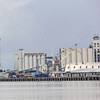U.S. public ports applauded passage on of H.R. 1480 by the U.S. House of Representatives to enact Water Resources Development Act (WRDA) legislation. WRDA legislation, among other things, authorizes deepening and modification of federal navigation projects at the nation's ports. Improving navigation infrastructure generates significant economic returns at the local, regional and national levels.
The Senate also passed its version of WRDA, S. 507. Major port projects in WRDA'99 include those along the Columbia River in Oregon and Washington; at the ports of Baltimore; Oakland; Savannah and Brunswick, GA; Jacksonville and Tampa. The Port Authority of New York and New Jersey also has a project modification in the bill. Project details are listed below.
Columbia River: This $183.6 million project will deepen the Columbia River shipping channel from 40 to 43 ft., to handle the new generation of large, deep-draft vessels when fully loaded. The draft Environmental Impact Statement shows an estimated national benefit of $38.7 million in average annual transportation cost savings. Each extra ft. of draft for a wheat ship, for example, means 2,000 tons of cargo or about $250,000 per ft. of added cargo capacity. Each extra ft. of draft for a container vessel means $2.5 million per ft. in added cargo capacity. The sponsors' proposed disposal plan would minimize environmental impacts while finding beneficial uses for the dredged material. Several ecosystem restoration and fish habitat projects have been added including creation of a 900 to 1,500-acre wetland near Shillapoo Lake, Washington.
Baltimore: Two improvement projects, a $28.4 million investment, are needed to widen and straighten navigation channels leading to the Port of Baltimore. These projects will enhance safety for modern ships operating in the Chesapeake Bay.
Savannah: Increases in the volume of cargo and the size of ships using Savannah Harbor are driving the need to deepen the harbor from 42 ft. to 48 ft. This $230 million project will improve the infrastructure that currently supports 80,100 jobs and $1.8 billion in payroll.
Brunswick: Without improvements for over 40 years, the navigation channel in Brunswick Harbor needs to be deepened to 36 ft. This $50 million project would return over $5.5 million in direct transportation cost savings to the nation every year.
Tampa: This $12.3 million project will allow the deepening to 41 ft. and widening of the federal channels serving the Port of Tampa. The Corps of Engineers has determined that these navigation improvements will mean $3.8 million in annual transportation cost savings; the project has a benefit cost ratio of 3.2 to 1.
Jacksonville: The $26 million project will deepen the St. Johns River federal channel from 38 ft. to a depth of 41 ft. and the Blount Island Marine Terminal's west channel from 30 ft. to a depth of 39 ft.. Each additional ft. of harbor depth allows 600 more TEUs, 2,000 additional tons of cargo or 8,000 more barrels of oil to be loaded on a ship. Without this project, the area's economic engine, which is responsible for 14,000 direct and indirect jobs with a payroll in excess of $400 million, would be at risk.
Oakland: This $214.3 million project will allow the Port to dredge the harbor to 50 ft. from the current 42 ft. to accommodate larger, more modern container vessels now used by the shipping industry. The dredged material from the project will be used to build a 190-acre shallow water marine habitat and for wetlands restoration projects.
Since WRDA '86, the Federal investment in improvements to the nation's navigation infrastructure is matched by a local share that varies depending on the depth of the project. These investments are also matched by billions of dollars of additional local investment in landside terminal facilities. Local ports must be able to rely on the Federal government delivering on its side of the partnership in development of the nation's marine transportation system by having predictable authorizations for navigation improvements.
Featured videos

Inmarsat Enhances Service to Drive Digitalization

Tracking Foreign Vessels Working in the U.S. Jones Act Market

Inside the Electrified Truckable Tug
Subscribe for
Maritime Reporter E-News
Maritime Reporter E-News is the maritime industry's largest circulation and most authoritative ENews Service, delivered to your Email five times per week









